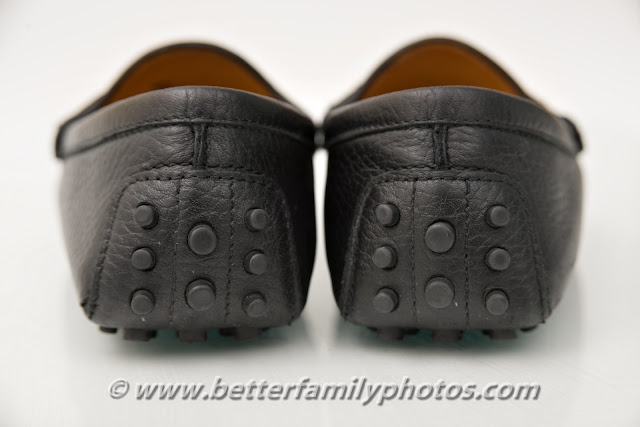With most subjects, the form and its texture is revealed by shadows. With black or very dark subjects, the shadows blend into the subject, therefore the shadows don't show its form as easily. Instead, we see the form through the specular highlights and reflections.
I took some photos of a pair of black leather shoes. In this post, I discuss how I lit the shot.
Because of the shoes' dark tone, I decided to take a photo of the shoes against a white backdrop. On some of the shots, I also wanted a cool-looking reflection below the shoes. To do this, I got a white construction paper and then used a glass top from one of our tables.
 |
| The tools I used. |
The objective here was to make the shoes as desirable as possible (they were to be sold on eBay or craigslist).
First, I tried a lighting scheme where the shoes were somewhat backlit, a style that I often like. To do this I placed one slave flash camera left, aimed at the left corner ceiling. I aimed the on-camera flash to the right corner of the ceiling. Here is the result:
The result looked somewhat ok, but did not show sufficient detail in the shoes. I tried to add detail by aiming the on-camera flash to the side and a little bit behind the camera plane. Here is the result:
Definitely had more detail but yuck the shiny specular reflection made the shoes look cheap.
A bit of explanation is in order. With light colored objects, the quality of light can be most easily seen by the shadows. Soft light produces soft-edged shadows. With dark objects, the shadows aren't as noticeable. Nonetheless, the quality of light still makes a difference -- through the specular highlights. Hard light produces very shiny specular reflections. Soft light produces a much more dull reflection.
The specular reflection here was because the wall to the right had a closet with a glass door. The glass door reflected the flash as though the flash were aimed directly at the shoes. To remedy this I aimed the on-camera flash at an angle that would not hit the glass door. This was the result:
Better than the previous shot, but still, there was a shiny specular reflection that detracted from the shoes' appearance. What I needed instead was to simulate a very large light source to create the softest-looking highlight. I did that by bouncing one flash behind and to the left, and the other behind and to the right. Together, the two bounced lights would act somewhat like a very large light source. This was the result:
Much improved, in my view. I then just adjusted the intensity.
In post, I removed some of the warm tint from the bounced flash. I did that in Photoshop by creating an adjustment layer that removed all saturation. To retain the color in the interior of the shoe I hid the adjustment layer over the interior of the shoe. The result had absolutely no tint while there was still color in the shoes' interior. However, I found the image a little too 'cold' looking, so I reduced the opacity of the adjustment layer to bring back just a little bit of the tint. This was the final shot:

Here is another shot I worked on. The initial shot had a highlight on the upper left that I found distracting, while the rest of the shoes were dark:
Once again, I adjusted the two flashes so that they bounced to the ceiling (behind the camera, because I was pointing the camera down). One flash was to the left of the shoes, and the other was on camera, both aimed at the ceiling to combine into a gigantic light source. The gigantic light source created a highlight that lit the shoes more evenly and gave the leather the soft appearance.
Here are the rest of the shots:






















0 comments:
Post a Comment